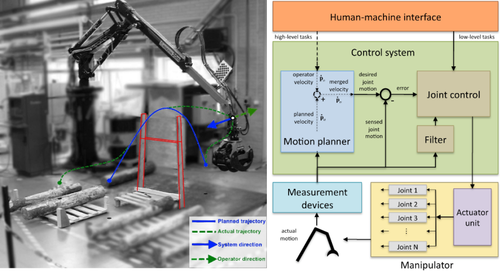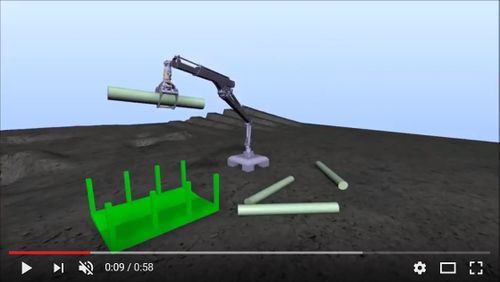Semi-Autonomous Crane: Difference between revisions
MartinServin (talk | contribs) No edit summary |
MartinServin (talk | contribs) No edit summary |
||
| Line 12: | Line 12: | ||
'''Rigid multibody dynamics model''' | '''Rigid multibody dynamics model''' | ||
'''Motion planning and tracking''' | The crane system is modeled as a multibody system using non-smooth dynamics. The crane model consists of 13 rigid bodies (2 for the base, 3 for the booms with 2 bodies as connections in-between and 3 hydraulic cylinders of 2 bodies each), and an additional 8 for the rotator and grapple, connected using kinematic constraints (hinge and prismatic) and actuated using secondary constraints (hinge motors and prismatic linear motors). These joints are made non-ideal by assigning compliance, viscous damping, and joint end-limits. The constraints motors are given force limits not to make the manipulator unnaturally strong. The actuation is controlled by assigned a desired joint velocity at each time-step. The resulting joint velocity depends on the inertia, dynamics, joint compliance and actuator force limits. | ||
Logs of different size and length were created for the crane to lift. The logs are modeled as cylindrical rigid bodies with realistic mass density, friction, and restitution. The contact model is based on non-penetration, Coulomb friction and Newtons law of impact. | |||
'''Motion planning and tracking for automatic loading''' | |||
The system is assumed to be equipped with ideal vision sensors that give the precise location of the logs and the tray. A motion planner algorithm generates smooth target trajectories for the gripper in Cartesian space, e.g., to place it above the center of a log or a specific point above the load tray. The Cartesian velocity is translated into joint velocities using inverse kinematics. | |||
A motion tracking algorithm compares the current position and velocity with the planned trajectory and generates a new motion plan from this. The Cartesian motion plan is represented either as linear segments or by cubic splines. | |||
'''Co-simulation''' | '''Co-simulation''' | ||
The | |||
'''Machine vision and perception''' | '''Machine vision and perception''' | ||
Revision as of 14:41, 29 January 2018
Industrial crane manipulators are widely used in mining, marine and forest environments. These are used for heavy and dangerous operations associated with the extraction, transport, and processing of raw materials and for various rescue operations. The electro-hydraulic and mechanical properties of large industrial manipulators make them difficult to control for both operators and using conventional control methods developed for industrial robots. Fast and stable motion control and semi-autonomous functions has emerged only recently in commercial systems. The lack of robust computer vision, however, severely limits the development of higher level autonomy, for example, ability to grip and move objects and to plan and predict the outcome of movements in unstructured environments.
We explore the use of computational modeling and multidomain dynamics with frictional contacts in the development of fully and semi-autonomous cranes. The research also address geometric design optimization of crane manipulators based on the computational model and simulation output.
Rigid multibody dynamics model
The crane system is modeled as a multibody system using non-smooth dynamics. The crane model consists of 13 rigid bodies (2 for the base, 3 for the booms with 2 bodies as connections in-between and 3 hydraulic cylinders of 2 bodies each), and an additional 8 for the rotator and grapple, connected using kinematic constraints (hinge and prismatic) and actuated using secondary constraints (hinge motors and prismatic linear motors). These joints are made non-ideal by assigning compliance, viscous damping, and joint end-limits. The constraints motors are given force limits not to make the manipulator unnaturally strong. The actuation is controlled by assigned a desired joint velocity at each time-step. The resulting joint velocity depends on the inertia, dynamics, joint compliance and actuator force limits.
Logs of different size and length were created for the crane to lift. The logs are modeled as cylindrical rigid bodies with realistic mass density, friction, and restitution. The contact model is based on non-penetration, Coulomb friction and Newtons law of impact.
Motion planning and tracking for automatic loading
The system is assumed to be equipped with ideal vision sensors that give the precise location of the logs and the tray. A motion planner algorithm generates smooth target trajectories for the gripper in Cartesian space, e.g., to place it above the center of a log or a specific point above the load tray. The Cartesian velocity is translated into joint velocities using inverse kinematics.
A motion tracking algorithm compares the current position and velocity with the planned trajectory and generates a new motion plan from this. The Cartesian motion plan is represented either as linear segments or by cubic splines.
Co-simulation
The
Machine vision and perception The lack of robust computer vision, however, severely limits the development of higher level autonomy, for example, ability to grip and move objects and to plan and predict the outcome of movements in unstructured environments. We explore model-based vision of objects in the manipulator's operating environment, such as tree logs, chains, pipes or rocks and boulders. The idea is to combine camera techniques for computer vision with realtime physics simulation. By fusing the data streams from cameras and other sensors with data from multiple parallel simulations the physically impossible interpretations can be excluded and object tracking become robust. When the input is insufficient, the crane manipulator can perturb the environment to generate a dynamic response that reveals additional information about the objects' geometry and physical nature.
Semi-autonomous control Text to come
Topology optimization Text to come
Publications
Servin M. Datorseende i granulära processer med realtidsfysik. Slutrapport från genomförbarhetsstudie inom det strategiska innovationsprogrammet Processindistriell IT och Automation (2017).
Servin M. Simulatorexperiment - datorseende skutknackare genom realtidsfysik. Umeå universitet (2017).
A. Hansson and M. Servin. Semi-autonomous shared control of large-scale manipulator arms. Control Engineering Practice, Elsevier, Vol 18, Issue 9, pp. 1069-1076 (2010). pdf, web

